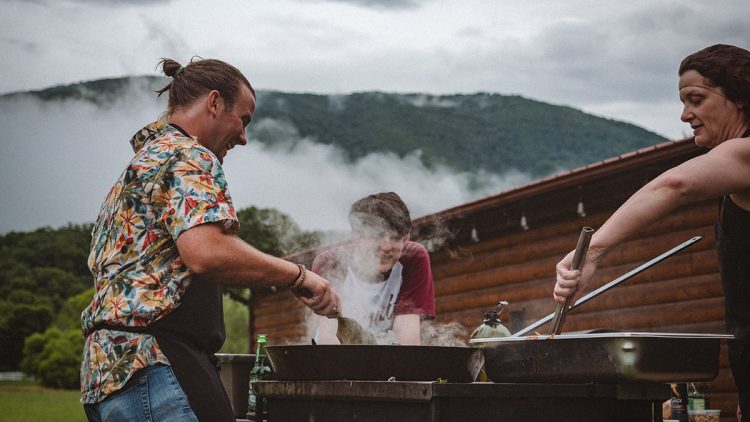Barbecues are a staple of summer. It’s pretty much an expectation you’ll be eating flame charred meals, drinking delicious cocktails, and enjoying the sun with friends. But hosting can be a bit stressful. Always wanting your food to be the best, planning what to cook, what order do you cook it in — it’s a lot to manage. But, there’s good news here. Frank Proto, director of culinary operations at the Institute of Culinary Education notes that even if the intention is to host a small gathering, grilling menus are often very flexible.
“Grilling is easily scalable, so you don’t necessarily need to change the menu based on the number of people,” he says.
For larger groups, he recommends shareable items that can be served buffet-style, like chicken thighs which can be chopped for lettuce wraps or steaks that can be used in tacos. He says individual items, like personal steaks, will be more manageable for a smaller group.
Proto also shared that when deciding what’s in your spread you should also add a few non-grilled items in, including sides and salads, for those people who may not favor grilled items. And, having a few items that don’t need to be heated will make for easy leftover picking while cleaning up later on.
Get Prepped
Make your party hosting easier with some simple prep work, which includes getting the grill ready to do its thing. Proto says waiting 15 to 20 minutes for your grill preheat gives you time to clean the unit. Hot tip: After you’re done cleaning the grill, use a little oil on the grates to avoid sticking food.
Matt Moore, chef and author of Serial Griller says that there is some work to be done on your main event (aka the meat) before hoisting it on to that grill like a pro. To ensure best results and a dish everyone will be “wowed” by, Moore recommends dry brining your meat with salt and leaving it out for about an hour. This will help remove the initial chill from the meat and give it the best chance of being tender. Additionally, he says, watch the seasoning.
“Putting too much seasoning on the meat can impact the meat’s natural flavor and how it interacts with the flame,” he says.”
It’s A Matter Of Time
Now that you’re set up for success, it’s time to put your feet to the fire. Start with the bigger cuts of meat (because they will take the longest to cook!), but also think about after cooking. Some meats, say Proto, will need time to rest and if you’re looking to serve everything warm together, you’ll want to take that time into consideration. “More delicate proteins, especially seafood, should be cooked later since they cook more quickly,” adds Proto.
Bring The Heat
Finally, we can jump into cooking. If you’re cooking multiple items at once, Moore recommends using different heat zones. Heat zones (depending on the type of grill) can be high, medium or low. For example, if you’re using a gas grill, one of your burners will be turned up to high and the other one can be lowered to medium. This, he says, gives you complete control and will lead to more tender and well cooked meat.
Moore is also a fan of having the meat, specifically steaks, browned all around. The charred marks we’re used to are less important to him so long as the color on the outside of the red meat is a nice, full brown.
Knowing when your meat is done is probably the hardest part of grilling. Proto recommends a thermometer for the most accurate method for checking the doneness. Steaks will be done at the following temps:
- Rare: 125F
- Medium-Rare: 130F
- Medium: 140F
- Medium-Well: 150F
- Well done: 160F
Red meats should rest for about 5 to 7 minutes after they come off the grill. Proto explains, “As the meat cooks, the juices inside move to the outside of the steak, so the resting time allows the juices to redistribute throughout the protein.”
Sensational Sides
We are going to take a break from meat for a second and give the vegetarians at the party a little assistance. Proto says you can grill polenta, tofu and cheese, scallions, onions, potatoes, corn, carrots, butternut squash, broccoli, Swiss chard and kale. That’s right, all of those things can also be made on the grill. You can also use Rougette Bonfire Grilling Cheese as an appetizer or serve it as a main course to the cheese lover at the party.
Don’t, however, forget the favorites. Potato salad, mac salad and coleslaw are always great additions to any cookout and can make prep and serving so much easier.
Sauce It Up
Another way to level up your barbecue is by using different sauces. Proto is a fan of chimichurri and salsa verde that add flavor to the grilled vegetables and meats.
Meanwhile, Moore recommends the Four Roses Classic Steak Sauce (recipe below). Bonus: These sauces can be made in advance, so all you have to do on the big day is cook your heart out!
Four Roses Classic Steak Sauce
- 1/4 cup ketchup
- 1 1/2 tablespoons Four Roses Bourbon
- 1 tablespoon balsamic vinegar
- 1 teaspoon lite soy sauce
- 1 teaspoon Worcestershire
- 1/4 teaspoon garlic powder
- 1/4 teaspoon onion powder
- 1/4 teaspoon black pepper
- 1 pinch crushed red pepper flakes
Mix all ingredients and enjoy. Refrigerate until ready to use.

